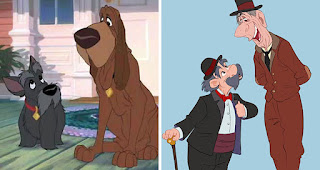Michael —Thursday
Stan’s blog last week about backstories made me think about the other features that flesh out our books and fiction in general. Character is obviously right up the list, but I was wondering about the minor characters and perhaps the very minor characters. Are animals characters or are they just part of the plot, or maybe even just part of the “sense of place”? It’s pretty clear that the answer is that they can be all three — just as is the case for human characters. There are the “extras” for crowd scenes and there are the bit parts.
In some novels animals become major characters or even the protagonist (for example, Paul Gallico’s Jennie). However, generally, when animals become major characters they are either assigned human personalities (i.e. they are really humans in animal clothing) or their personalities are reflections of the human characters interacting with them.
 |
| You can look at this either way... |
It’s intriguing to imagine a true animal protagonist, but the issue is that we really have no idea how animals think or even what their senses report to their brains. We know that dogs are much more sensitive to smell than we are and tend to find scents more interesting that sounds or sights. Do their brains process the age of the scent in some way, building a picture of the past and the present of a place at the same time? It seems unlikely. Probably they simply react more to a stronger, more recent, scent, but we don’t know.
 |
| Grey Go-Away-Bird |
In the next Kubu book, The Second Death of Goodluck Tinubu (A Deadly Trade outside North America), an animal plays the role of a minor character. Moremi, the cook at a game lodge, has a pet, wild, bird – a grey go-away-bird. The species has a harsh alarm call, and with a bit of imagination the call can be interpreted as “go away", leading to its English name. But Moremi isn’t English so he calls the bird Kweh. Kweh has personality, but much of that is assigned by the cook himself. And, in turn, Moremi’s loner personality is revealed through the bird. Here's a short extract:
Kubu and Joy have a fox-terrier named Ilya as part of their
family. Ilya plays roles between crowd-scene participant and bit part in the
various books. Her main role is to reflect a Bengu family dynamic, a dynamic
that changes when Kubu and Joy have a child.
 |
| White Rhino Kruger National Park |
Of all our books, the stand-alone thriller Shoot the Bastards (Dead of Night outside North America) might be the one that seems most steeped in animals. Crys Nguyen is investigating the rhino poaching and horn smuggling scourge in South Africa. Much of the book takes place in the African wilderness (the “bush” as we call it). Obviously, rhinos are involved in the plot – they are the centre of the plot, elephants play crowd-scene roles, and the bush animals give a strong sense of place. But no animals are characters. As a new visitor to Africa, Crys doesn’t have the time or the mental space to interact with the animals at that level. She has a much more personal relationship with animals in Wolfman.
What role do animals play in the books you write? What role
would you like them to play in the mysteries you read?

















IN my Africa series, I guess my animals mostly provide a sense of place. They also affect the characters state of mind—fear of them, interest in them, etc. In Strange Gods a snake affects the plot. In Idol of Mombasa, there is a scary scene where the insects I can’t say more to avoid spoilers.
ReplyDeleteIn my WIP, which takes place in Sicily at the end of the 17th Century, there are animals who are major characters. I love what they decided to do to my story.
I think pets can inform the reader about the character. A woman with a husky is a very different person to a woman with a pyjama wearing dog that she keeps in her handbag. Where would the famous five be without Timmy? In my last book, the detective got his dog put down. The dog was about 37 by that time. I still got emails of abuse!!
ReplyDeleteOh, yeah! I forgot about Timmy with the Famous Five!
DeleteIn a few of my novels there's a small, sandy-colored dog hanging around taking a canine interest in what's going on--it usually trots off to attend to business. This comes from the observation of Ghanaian city dogs that apparently belong to no one and are highly independent, streetwise, and non-needy. They even know how to cross the street, looking left, right and left again before they start across. Once I tried to follow one of them to see where it was so busily going, but 2 legs were no match for four! In general, these dogs are small and lean to conserve energy, and are either light brown or white and brown.
ReplyDeleteIn my Wolfman, Not only are wolves the reason for all of Crystal's actions, but she anthropomorphised a dying wolf trying to get help. That episode (in her mind) led her to the world of conservation. Humans are very good at implanting the human condition into animals.
ReplyDelete